Getting locked out of your car is a frustrating experience, but knowing how to get into a locked car without a key can turn a stressful situation into a manageable one. CARS.EDU.VN provides expert guidance on various methods, from simple DIY techniques to professional solutions, ensuring you regain access to your vehicle quickly and safely. Discover locksmith alternatives and emergency car opening strategies to handle lockouts effectively.
1. Staying Calm and Assessing Your Locked Car Situation
Before taking any action, it’s crucial to remain calm and evaluate your options when you’re locked out of your car. Panicking can lead to poor decisions. Take a moment to assess the situation, consider any available tools, and decide whether you need immediate professional assistance. This initial assessment can save time and prevent potential damage to your vehicle.
2. Contacting a Locksmith or Roadside Assistance for Car Entry
If you’re unable to unlock your car yourself, calling a qualified locksmith or roadside assistance service is a dependable solution. Many auto insurance policies include lockout services, so it’s wise to check your coverage before making the call. This is generally the safest and most reliable way to unlock your car doors without risking damage to your vehicle’s locking mechanisms or electronics. For reliable service, you can contact us at 456 Auto Drive, Anytown, CA 90210, United States, or via Whatsapp at +1 555-123-4567.
3. Using a Slim Jim to Unlock a Car Door Without a Key
A Slim Jim is a tool commonly used by professionals to unlock cars without keys. It’s a long, flat metal strip with a hooked end designed to manipulate the car’s internal locking mechanism. While effective on older cars with manual locks, using a Slim Jim requires caution to avoid damaging the vehicle’s electronic components. According to Popular Mechanics, understanding the mechanism is crucial to avoid damage.
3.1. Steps for Safely Using a Slim Jim
- Carefully slide the Slim Jim between the weather stripping and the window.
- Gently feel for the lock mechanism inside the door.
- Once located, hook onto the lock and gently pull upwards to unlock the door.
4. The Coat Hanger Method: A DIY Approach to Car Unlocking
A simple DIY method to unlock your car door involves using a wire coat hanger. This approach is most effective on older vehicles equipped with manual locks, where electronic systems are less likely to be affected. Always handle the hanger carefully to prevent scratches.
4.1. Steps to Use a Coat Hanger to Open Your Car Door
- Uncoil the wire coat hanger and bend one end to form a small hook.
- Insert the hooked end between the window and the weatherstripping.
- Carefully maneuver the hook around the lock button inside the door.
- Pull up on the hook to unlock the door, applying gentle pressure.
5. Unlocking a Car Door with String or Shoelace: A Clever Technique
In situations where you don’t have access to a Slim Jim or coat hanger, you can use string or a shoelace to unlock certain car models. This technique is particularly effective on vehicles that have vertical lock buttons. Practice and patience are essential for success.
5.1. Steps to Unlock Your Car Door Using String or Shoelace
- Create a slipknot at the center of the string or shoelace.
- Carefully insert the string between the car door and the top of the window frame.
- Maneuver the string to loop the slipknot around the lock button.
- Tighten the knot by pulling the ends of the string.
- Once secured, gently pull upwards to unlock the car door.
6. Using an Inflatable Wedge to Gain Car Access
Another tool commonly used by professionals is an inflatable wedge, which allows for a non-destructive entry into a locked vehicle. This technique involves inserting the wedge between the door and the car frame, then inflating it to create a gap large enough to insert a tool to manipulate the door’s locking mechanism. Ensure you use the right pressure to prevent damage.
6.1. Steps for Using an Inflatable Wedge
- Insert the deflated wedge into the space at the top corner of the car door.
- Inflate the wedge slowly to create a gap between the door and the frame.
- Insert a long, slender tool through the gap to reach the car’s internal unlock button.
- Press the unlock button to open the door.
7. Unlocking Your Car with a Mobile App
Modern vehicles often come equipped with mobile app compatibility that allows for remote unlocking. Apps like MyChevrolet, FordPass, and Hyundai Blue Link enable you to unlock your car directly from your smartphone, provided the service is activated. For more information on compatible models, visit Edmunds.
7.1. Steps to Unlock Your Car Using a Mobile App
- Download the app that corresponds to your car’s make and model from your smartphone’s app store.
- Register and connect the app to your car’s system using the vehicle identification number (VIN).
- Navigate to the “unlock” function within the app.
- Tap the “unlock” button to remotely open your car doors.
8. Utilizing a Windshield Wiper Blade for Car Entry
An unconventional method to unlock a car door involves using a windshield wiper blade. This is most suitable for cars with manual locks and when you can easily remove the blade. While not ideal, it can serve as a temporary solution.
8.1. Steps to Unlock Your Car Using a Windshield Wiper Blade
- Remove one of the windshield wiper blades from your car.
- Carefully slide the thin, metal part of the blade between the window and the door.
- Attempt to manipulate the locking mechanism by wiggling the blade until the door unlocks.
9. Opening a Car Door with a Bobby Pin: A DIY Lock-Picking Attempt
For individuals with a knack for DIY solutions, a bobby pin can be used as a makeshift lock-picking tool. While not as reliable as other methods, it might work in a pinch if you’re out of options. Proceed with caution to avoid damaging the lock.
9.1. Steps to Unlock Your Car Door with a Bobby Pin
- Straighten a bobby pin and insert it into the car’s keyhole.
- Jiggle and maneuver the pin around inside the lock to feel for the locking mechanism.
- Apply slight pressure while attempting to turn or release the lock.
10. Calling a Friend or Family Member for Assistance
If none of the previous methods are feasible or safe, reaching out to a friend or family member is a reliable backup plan. Many people leave spare keys with someone they trust, which can be the quickest way to regain access to your car.
11. Understanding Car Lock Systems
Understanding the different types of car lock systems can help you choose the best method to unlock your vehicle. Here’s a comparison of common systems:
| Lock System Type | Description | Best Method for Unlocking |
|---|---|---|
| Manual Locks | Older systems, require physical key or manual button to lock/unlock. | Slim Jim, Coat Hanger, String/Shoelace |
| Power Locks | Electronically controlled locks, often with remote key fob. | Mobile App, Inflatable Wedge (to access button) |
| Keyless Entry Systems | Use a key fob that transmits a signal to lock/unlock car. | Mobile App (if equipped), Locksmith |
| Advanced Security Systems | Include immobilizers, alarms, and GPS tracking. | Locksmith, Roadside Assistance |
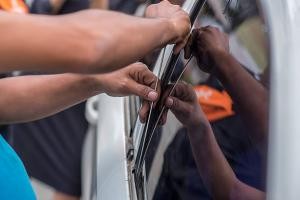
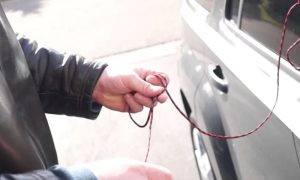
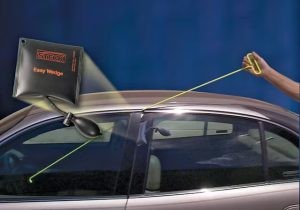
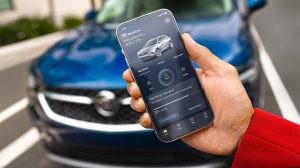
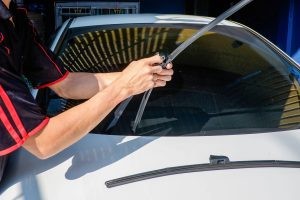
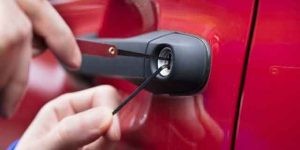
12. Preventing Future Car Lockouts
Preventing future car lockouts is crucial to avoid the stress and inconvenience of being stranded. Here are proactive steps you can take:
- Always carry a spare key: Keep a spare key in a secure, accessible location, or give it to a trusted friend or family member.
- Consider installing a keyless entry system: Upgrade your vehicle with a modern keyless entry system that uses a code or smartphone app for access.
- Regularly check your car’s lock functions: Ensure that your car’s locks are functioning correctly to prevent unexpected malfunctions.
- Avoid rushing when exiting your vehicle: Always double-check that you have your keys before closing and locking the door.
13. How to Choose the Right Locksmith
Choosing the right locksmith is essential for ensuring the security of your vehicle and receiving professional, reliable service. Here are key factors to consider:
- Check for Licensing and Certification: Verify that the locksmith is licensed and certified, ensuring they meet industry standards.
- Read Online Reviews: Look for reviews on sites like Google, Yelp, and the Better Business Bureau to gauge the locksmith’s reputation.
- Ask for an Estimate: Obtain a detailed estimate before any work begins to avoid hidden fees or unexpected costs.
- Ensure Availability: Choose a locksmith that offers 24/7 emergency services for lockout situations.
- Verify Insurance: Confirm that the locksmith is insured to protect against any potential damage during the service.
14. The Cost of Different Unlocking Methods
Understanding the costs associated with different unlocking methods can help you make an informed decision based on your budget and situation:
| Method | Average Cost | Pros | Cons |
|---|---|---|---|
| DIY Methods (Coat Hanger, String) | $0 – $5 | Low cost, readily available tools | May not work on all vehicles, risk of damage |
| Inflatable Wedge and Rod | $20 – $50 | Effective, can be used on various vehicles | Requires purchasing tools, may damage door if not used carefully |
| Locksmith Services | $50 – $150+ | Professional, reliable, can handle complex lock systems | Higher cost, may take time for arrival |
| Roadside Assistance (AAA, etc.) | Included in membership | Convenient, often included in auto insurance | May have long wait times, limited service area |
| Mobile App (Remote Unlock) | Free (with subscription) | Convenient, quick, no physical tool required | Requires vehicle compatibility, subscription fees may apply |
15. Understanding Automotive Lock Technologies
Familiarizing yourself with modern automotive lock technologies can help you understand how to address lockout situations more effectively. Here’s an overview of key technologies:
- Remote Keyless Entry (RKE): Systems that allow you to lock and unlock your car from a distance using a key fob.
- Smart Keys: Advanced key fobs with built-in transponders that communicate with the car’s immobilizer system to prevent theft.
- Biometric Locks: Systems that use fingerprint or facial recognition to unlock the car.
- Smartphone Integration: Mobile apps that allow you to control your car’s locks, start the engine, and monitor vehicle status remotely.
16. Safety Tips for DIY Car Unlocking
When attempting to unlock your car using DIY methods, safety should always be your top priority. Here are essential safety tips to follow:
- Avoid Damaging the Vehicle: Use gentle pressure and avoid forcing any tools to prevent damage to the car’s locks, windows, or body.
- Protect Your Hands: Wear gloves to protect your hands from sharp edges or splinters when using tools like coat hangers or wiper blades.
- Be Aware of Your Surroundings: Choose a safe location away from traffic and potential hazards when attempting to unlock your car.
- Don’t Obstruct Traffic: Ensure that your car is parked safely and does not obstruct traffic or create a safety hazard for other drivers.
- Call for Help if Needed: If you are unable to unlock your car safely, don’t hesitate to call a professional locksmith or roadside assistance.
17. New Car Models with Advanced Lock Features
Many new car models come equipped with advanced lock features that offer enhanced security and convenience. Here’s a look at some of the latest innovations:
| Car Model | Advanced Lock Features | Benefits |
|---|---|---|
| Tesla Model 3 | Keyless entry via smartphone app, PIN-to-drive feature | Enhanced security, convenient access without physical keys |
| BMW 5 Series | Digital Key Plus (car access via Apple Wallet), remote locking/unlocking | Seamless integration with digital devices, enhanced convenience |
| Audi e-tron | Remote access via myAudi app, geofencing capabilities | Remote vehicle monitoring, increased security, ability to set virtual boundaries |
| Hyundai Sonata | Digital Key (unlock via smartphone), remote start and climate control | Enhanced convenience, remote vehicle management |
| Land Rover Range Rover | Activity Key (waterproof wristband for keyless entry), remote locking/unlocking | Ideal for outdoor activities, secure access without carrying a traditional key |
18. Common Mistakes to Avoid When Locked Out
Avoiding common mistakes when locked out of your car can prevent further complications and potential damage. Here are pitfalls to steer clear of:
- Panicking: Staying calm is crucial to assessing the situation and making rational decisions.
- Forcing Tools: Avoid using excessive force when using tools to unlock your car, as this can damage the locking mechanism or body.
- Damaging the Weather Stripping: Be careful when inserting tools between the window and door to avoid tearing or damaging the weather stripping.
- Ignoring Safety: Always prioritize safety by choosing a safe location and wearing protective gear when attempting DIY unlocking methods.
- Delaying Professional Help: If you are unable to unlock your car safely, don’t hesitate to call a professional locksmith or roadside assistance.
19. How to Maintain Your Car Locks
Proper maintenance of your car locks can prevent lockouts and ensure the security of your vehicle. Here are essential maintenance tips:
- Regular Lubrication: Apply a silicone-based lubricant to the keyholes and locking mechanisms to keep them functioning smoothly.
- Clean Keyholes: Use compressed air to remove dirt and debris from the keyholes, preventing jams.
- Inspect Key Fobs: Regularly check the batteries in your key fobs and replace them as needed.
- Avoid Using Damaged Keys: Replace bent or damaged keys to prevent them from getting stuck or breaking off in the lock.
- Check Power Locks: Periodically test your power locks to ensure they are functioning correctly.
20. The Future of Car Entry Systems
The future of car entry systems is evolving rapidly, with advancements in technology offering enhanced security, convenience, and personalization. Here are emerging trends to watch:
- Biometric Entry: Systems that use fingerprint, facial recognition, or voice recognition to unlock the car.
- Blockchain Technology: Secure, decentralized systems for managing vehicle access and ownership.
- Over-the-Air Updates: Software updates that improve the security and functionality of car entry systems.
- Personalized Settings: Car entry systems that automatically adjust settings such as seat position, climate control, and music preferences based on the driver’s profile.
- Enhanced Cybersecurity: Advanced security measures to protect car entry systems from hacking and unauthorized access.
21. Legal Aspects of Unlocking a Car
Understanding the legal aspects of unlocking a car is essential to ensure that you are acting within the bounds of the law. Here are key considerations:
- Proof of Ownership: You must be able to prove that you own the vehicle before attempting to unlock it or hiring a locksmith.
- Locksmith Regulations: Locksmiths are often required to be licensed and follow specific regulations to ensure ethical and legal practices.
- Trespassing Laws: Be aware of trespassing laws if you need to access your car on private property.
- Liability for Damage: You may be liable for any damage caused to the vehicle while attempting to unlock it.
- Reporting Stolen Vehicles: If you suspect that your car has been stolen, contact the police immediately instead of attempting to unlock it yourself.
22. Environmental Factors Affecting Car Locks
Environmental factors can significantly impact the performance and reliability of car locks. Here are key factors and how to mitigate their effects:
- Extreme Temperatures: Hot and cold temperatures can cause locks to expand or contract, leading to jams or malfunctions.
- Humidity and Moisture: High humidity can cause corrosion and rust, affecting the locking mechanism.
- Dust and Debris: Dust and debris can accumulate in the keyholes, causing them to become clogged.
- Salt Exposure: Salt from road salt or coastal environments can corrode metal parts, leading to lock failure.
- Sunlight Exposure: Prolonged exposure to sunlight can damage the plastic and rubber components of the locking system.
22.1. Mitigation Strategies
- Use Lubricants: Apply silicone-based lubricants to protect against corrosion and ensure smooth operation.
- Cover Your Vehicle: Use a car cover to protect against extreme weather conditions.
- Regular Cleaning: Clean the keyholes and locking mechanisms regularly to remove dust and debris.
- Wash Your Car: Wash your car frequently to remove salt and prevent corrosion.
23. Statistics on Car Lockouts
Understanding the statistics on car lockouts can highlight the frequency and impact of these situations, underscoring the importance of being prepared.
- Frequency: According to a study by AAA, an estimated four million drivers experience car lockouts each year in the United States.
- Causes: The most common causes of car lockouts include lost keys, accidentally locking keys inside the car, and malfunctioning key fobs.
- Timing: Car lockouts are more likely to occur during extreme weather conditions, such as hot summer days or cold winter nights.
- Demographics: Drivers aged 25-44 are the most likely to experience car lockouts.
- Costs: The average cost of a locksmith or roadside assistance service for a car lockout ranges from $50 to $150.
24. How CARS.EDU.VN Can Help
At CARS.EDU.VN, we understand the frustration and stress of being locked out of your car. That’s why we provide expert guidance and resources to help you resolve lockout situations quickly and safely. Whether you need detailed step-by-step instructions, professional advice, or assistance in finding a reliable locksmith, CARS.EDU.VN is your trusted partner.
- Comprehensive Guides: Access our extensive library of articles and guides on car maintenance, repair, and emergency situations.
- Expert Advice: Get personalized advice from our team of automotive experts.
- Local Locksmith Directory: Find a reputable locksmith in your area through our directory of trusted service providers.
- DIY Tips and Tricks: Learn valuable DIY tips and tricks for handling common car problems, including lockouts.
- Preventive Maintenance Tips: Discover how to prevent future lockouts and keep your car in top condition.
Don’t let a car lockout ruin your day. Visit cars.edu.vn today for all your automotive needs. Whether you’re dealing with a lockout, need routine maintenance, or are looking to upgrade your vehicle, we have the resources and expertise to help you succeed. Our team is dedicated to providing you with reliable information and practical solutions to keep you on the road. Contact us at 456 Auto Drive, Anytown, CA 90210, United States, or via Whatsapp at +1 555-123-4567 for immediate assistance.
25. Emerging Technologies in Automotive Security
The automotive industry is constantly evolving, with new technologies emerging to enhance vehicle security and convenience. Here are some of the latest innovations in automotive security:
- Advanced Driver Assistance Systems (ADAS): Features such as lane departure warning, blind-spot monitoring, and automatic emergency braking can help prevent accidents and reduce the risk of theft.
- Biometric Authentication: Systems that use fingerprint or facial recognition to verify the driver’s identity and prevent unauthorized access.
- Cloud-Based Security: Cloud-based platforms that monitor vehicle data and detect potential security threats in real time.
- Cybersecurity Measures: Advanced cybersecurity protocols to protect vehicle systems from hacking and unauthorized access.
- Over-the-Air (OTA) Updates: The ability to update vehicle software wirelessly, ensuring that security systems are always up to date.
26. Comparative Analysis of Car Unlocking Tools
Choosing the right tool for unlocking your car depends on various factors, including the type of lock, your skill level, and the availability of tools. Here’s a comparative analysis of common car unlocking tools:
| Tool | Description | Pros | Cons | Skill Level Required |
|---|---|---|---|---|
| Slim Jim | Long, flat metal strip with a hooked end for manipulating the lock mechanism. | Effective on older cars with manual locks, widely used by professionals. | Can damage electronic components on newer cars, requires knowledge of internal locking mechanisms. | Intermediate |
| Coat Hanger | A wire coat hanger bent into a hook shape for pulling up the lock button. | Low cost, readily available, simple to use. | May not work on all vehicles, can damage the car’s interior or weather stripping. | Beginner |
| String/Shoelace | A string or shoelace tied into a slipknot for looping around the lock button. | No special tools required, can work on vehicles with vertical lock buttons. | Requires practice, may not work on all vehicles. | Beginner |
| Inflatable Wedge | An inflatable wedge used to create a gap between the door and the frame. | Allows for non-destructive entry, provides access to the unlock button. | Requires purchasing the tool, may damage the door if over-inflated. | Intermediate |
| Mobile App | A smartphone app for remotely unlocking the car. | Convenient, quick, no physical tool required. | Requires vehicle compatibility, may require a subscription. | Beginner |
27. How Locksmiths Open Different Car Models
Locksmiths use various techniques and tools to open different car models, depending on the type of lock and the vehicle’s security system. Here’s an overview of how locksmiths approach common car models:
| Car Model | Common Locking System | Locksmith Techniques | Tools Used |
|---|---|---|---|
| Older Sedans | Manual Locks | Slim Jim, jiggling the lock, using a try-out key. | Slim Jim, try-out keys, lock picks. |
| Modern Sedans | Power Locks, Keyless Entry | Using an inflatable wedge to access the unlock button, programming a new key fob, using a diagnostic tool. | Inflatable wedge, key programmer, diagnostic tool. |
| Luxury Vehicles | Advanced Security Systems | Decoding the car’s security system, using specialized lock picks, programming a new key fob. | Specialized lock picks, key programmer, diagnostic tool. |
| Electric Vehicles (EVs) | Smartphone Integration | Using the vehicle’s mobile app, contacting the manufacturer for remote unlocking assistance. | Smartphone, manufacturer’s support. |
28. Insurance Coverage for Car Lockouts
Understanding your insurance coverage for car lockouts can save you money and provide peace of mind. Here’s what you need to know about insurance coverage for car lockouts:
- Comprehensive Coverage: Comprehensive coverage typically covers car lockouts, as it covers events not caused by a collision.
- Roadside Assistance Coverage: Many insurance companies offer roadside assistance coverage as an add-on to your policy, which includes lockout services.
- AAA Membership: AAA membership provides roadside assistance services, including car lockouts, for a yearly fee.
- Deductibles: Check your policy to see if a deductible applies to lockout services.
- Limitations: Some policies may have limitations on the number of lockout services covered per year.
29. Community Resources for Car Owners
Connecting with local community resources can provide valuable support and assistance for car owners. Here are some helpful resources:
- Local Auto Clubs: Join a local auto club for access to discounts, roadside assistance, and educational resources.
- Community Workshops: Attend community workshops on car maintenance and repair to learn valuable skills and tips.
- Online Forums: Participate in online forums and communities for car owners to share experiences, ask questions, and get advice.
- Local Mechanics: Establish a relationship with a trusted local mechanic for routine maintenance and repairs.
- Emergency Services: Know the contact information for local emergency services in case of a car lockout or other emergency situations.
30. FAQ About Getting Into a Locked Car
Here are some frequently asked questions about how to get into a locked car:
- What is the first thing I should do if I lock my keys in the car?
- Stay calm, assess the situation, and check if you have a spare key or roadside assistance coverage.
- Can I use a coat hanger to unlock any car?
- Coat hangers are most effective on older cars with manual locks. Newer cars with electronic systems may require different methods.
- Is it safe to use a Slim Jim on my car?
- Using a Slim Jim requires caution to avoid damaging the car’s electronic components. If you’re unsure, it’s best to call a professional.
- How much does it cost to hire a locksmith for a car lockout?
- The average cost ranges from $50 to $150, depending on the complexity of the lock and the locksmith’s rates.
- Does my car insurance cover lockout services?
- Many auto insurance policies include coverage for lockout services, either as part of comprehensive coverage or roadside assistance.
- Can I unlock my car using a mobile app?
- Some newer vehicles come equipped with mobile app compatibility that allows for remote unlocking.
- What are the risks of trying to unlock my car myself?
- DIY methods can potentially damage the car’s locks, windows, or body if not done carefully.
- How can I prevent future car lockouts?
- Always carry a spare key, consider installing a keyless entry system, and regularly check your car’s lock functions.
- What should I do if I suspect my car has been stolen?
- Contact the police immediately instead of attempting to unlock it yourself.
- Where can I find a reliable locksmith in my area?
- Check online directories like Yelp, Google, and the Better Business Bureau, and ask for recommendations from friends and family.